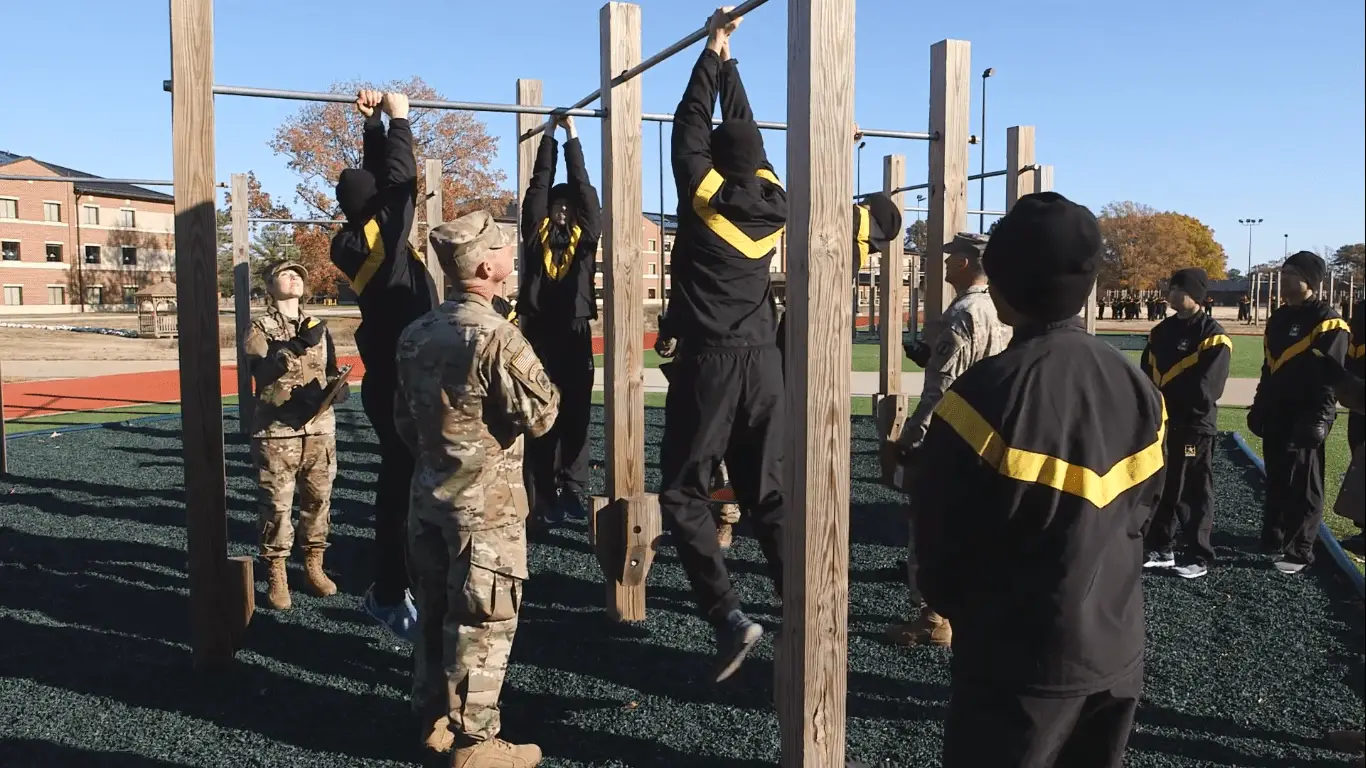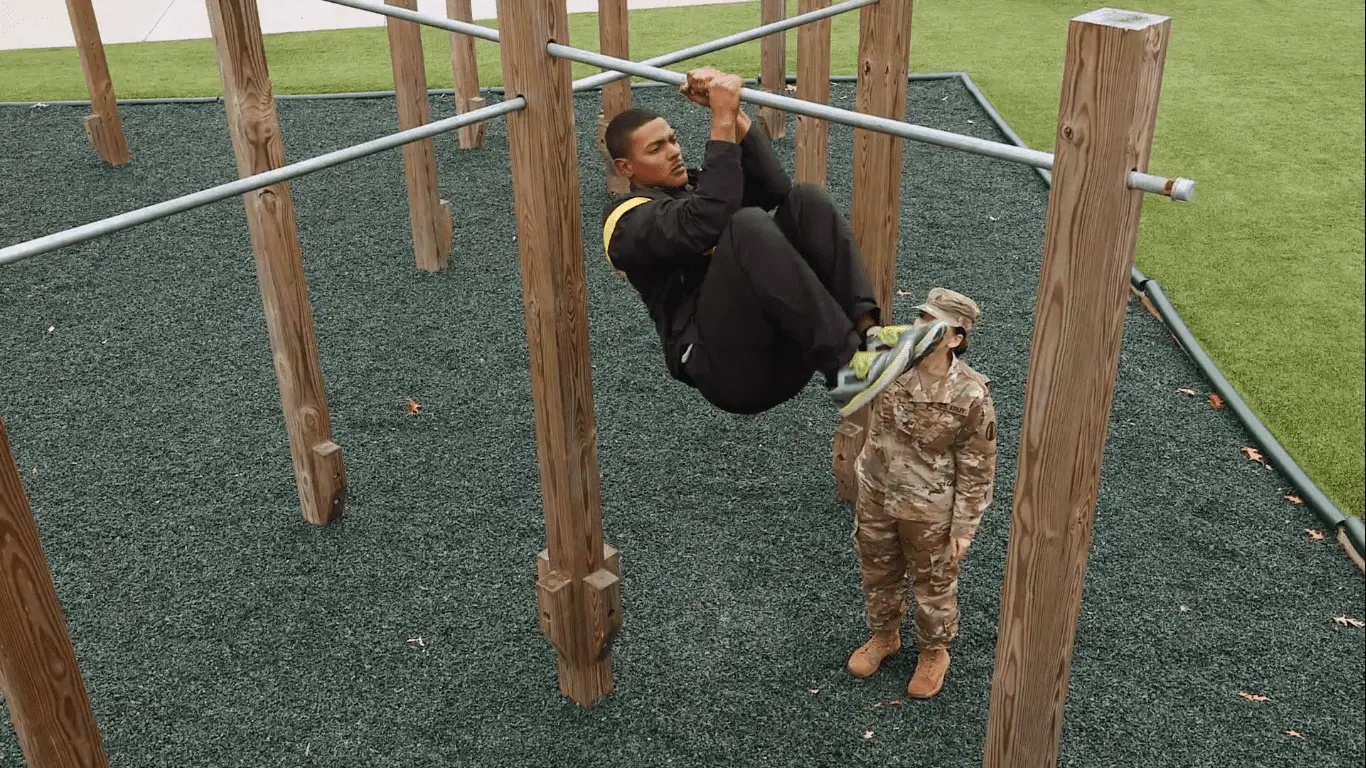Leg Tuck (LTK) - Army ACFT Event
 Complete as many leg tucks as possible. This requires the soldier to work out core muscles by lifting their legs to their elbows and is described as being similar to a pull-up.
Complete as many leg tucks as possible. This requires the soldier to work out core muscles by lifting their legs to their elbows and is described as being similar to a pull-up.
Fitness Components:
This event measures muscular strength and endurance. It assesses grip strength, shoulder adduction and flexion, elbow flexion, and trunk and hip flexion.
Equipment:
Climbing bar
Scoring:
60 and 100 point scores: One and 20 reps
Proper Technique:
Starting position
On the command “GET SET,” one Soldier from each lane will mount the bar and assume a straight-arm hang on the bar, with feet off the ground, knees bent if necessary. Graders may assist Soldiers up onto the bar. The grip is the alternating grip (recommend placing the dominant hand closest to the head). The body is perpendicular to the bar, however, the alternating grip will cause the body to rotate outward slightly. The Soldier’s body must be fully extended in a straight arm position (elbows, trunk, and hips are straight). Legs and feet may not be crossed; feet must be off the ground with knees bent if necessary. 
Execution
On the command “GO,” the Soldier will flex at the elbows, knees, hips, and waist to lift the knees. Flexing the elbows assists with this movement. The right and left knees or thighs must touch the right and left elbows, respectively. The grader must observe both knees or thighs in contact with both elbows for the Soldier to receive credit for the repetition.  The Soldier will return under control to the straight-arm position, elbows straight, to complete each repetition. If the elbows remain bent, the next repetition will not count. The Soldier does not have to be completely still. Small, inconsequential, or passive movement of the body and twisting of the trunk is permitted. Deliberately swinging the trunk and legs to assist with lifting the knees is not permitted and will cause the subsequent repetition to not count.
The Soldier will return under control to the straight-arm position, elbows straight, to complete each repetition. If the elbows remain bent, the next repetition will not count. The Soldier does not have to be completely still. Small, inconsequential, or passive movement of the body and twisting of the trunk is permitted. Deliberately swinging the trunk and legs to assist with lifting the knees is not permitted and will cause the subsequent repetition to not count.
- It can rest in the straight-arm (down) position and may adjust grip positions by moving the hands.
- Cannot touch the ground during grip adjustments.
- Cannot drop from the bar before assuming the straight-arm hang position UNDER CONTROL in order for the last repetition to count.
The event will be terminated when the Soldier voluntarily stops or involuntarily drops from the bar. Using the vertical posts to rest or push from will also be grounds for termination.
Recommended Training:
Bent Leg Raise
- The starting position for the Bent-Leg Raise is the supine position with knees bent to 90 degrees, feet flat on the ground. Hands are placed under the SMALL OF THE BACK, not the pelvis, with palms on the ground. Head is 2-4 inches off the
- On the command of “ready, EXERCISE,” raise both feet from the ground until both knees and hips flex to 90 degrees. While concentrating on the amount of pressure placed on the hands from the spine, slowly straighten the legs. Maintain this pressure for up to 60
- If the pressure on the hands reduces or the Soldier needs to rest, bring the knees back to the chest for 3-5 seconds until resuming the
- On the command of “starting position, MOVE,” return to the starting
Leg Tuck and Twist
- The starting position for the Leg Tuck and Twist is the supported reclining seated Hands are on the ground to the rear of the shoulders, palms down. Legs are straight and kept together with the feet 8-12 inches above the ground.
- On count 1, raise the legs while rotating onto the left buttock and drawing the knees toward the left shoulder. Maintain control of the leg movement and trunk
- On count 2, reverse the movement performed in count 1 to return to the starting
- On count 3, repeat count 1, this time rotating the legs to the
- On count 4, return to the starting
Alternating Grip Pull-Ups
- The starting position for the Alternating Grip Pull Up is the straight-arm hang using the closed alternating grip. This positions the Soldier perpendicular to the
- IF the Soldier states “no spotter needed,” the two spotters are not Otherwise, the spotters assume Staggered Stance positions in the front and back of the exerciser.
- The front spotter places palms toward the exerciser at chest height to support the exerciser if their grip fails.
- The rear spotter holds the exerciser’s feet against their thighs or abdomen to support the movement up. Once the Soldier is up, the rear spotter stops
- On count 1, flex the elbows, raising the body up so that the head moves to the side of the
- On Count 2, return to the starting
- Repeat the exercise 5-10
- Spotters may assist in guiding the exerciser to the footpegs after the command of “down” prior to the command of “dismount”.
Combat Readiness:
This exercise strengthens the core muscles and helps you with Surmounting obstacles and walls and Rope climbing, descending or traversing
